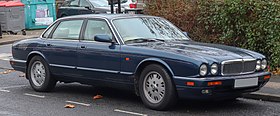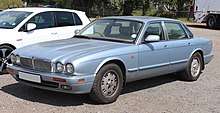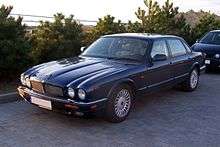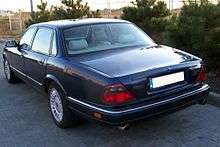Jaguar XJ (X300)
The Jaguar XJ (X300) is a full-size luxury sedan manufactured by Jaguar Cars between 1994 and 1997. It was the first XJ produced entirely under Ford ownership, and can be considered an evolution of the outgoing XJ40 generation. Like all previous XJ generations, it features the Jaguar independent rear suspension arrangement. The design of the X300 placed emphasis on improved build quality, improved reliability, and a return to traditional Jaguar styling elements.[2][3]
| Jaguar XJ (X300) | |
|---|---|
 Jaguar XJ6 | |
| Overview | |
| Manufacturer | Jaguar Cars |
| Also called |
|
| Production | July 1994 –June 1997 (92,038 produced)[1] |
| Assembly | Coventry, England |
| Designer | Geoff Lawson (1991) |
| Body and chassis | |
| Class | Full-size luxury car (F) |
| Body style | 4-door sedan |
| Layout | Front-engine, rear-wheel-drive |
| Powertrain | |
| Engine |
|
| Transmission | |
| Dimensions | |
| Wheelbase |
|
| Length |
|
| Width |
|
| Height |
|
| Kerb weight |
|
| Chronology | |
| Predecessor | Jaguar XJ (XJ40) |
| Successor | Jaguar XJ (X308) |
At the car's launch in October 1994 at the Paris Motor Show, Jaguar marketing material made use of the phrase "New Series XJ" to describe the X300 models. The X300 series represented the result of a £200 million facilities renewal program by Ford.[4] The program introduced state-of-the-art automated body welding robots manufactured by Nissan, and was intended to show the future direction of the British auto industry.
Exterior

Aesthetically, the X300 received several updates in the design refresh led by Geoff Lawson in 1991. The mostly flat bonnet of the XJ40 was replaced with a fluted, curvaceous design that accentuated the four separate round headlamps. Rear wings were reshaped to accommodate the new wrap-around rear light clusters. Also, the separate black-rubber bumper bar of the XJ40 was replaced with a fully integrated body-coloured bumper. The Jaguar "leaper" hood mascot was installed only on cars for non-European markets.
Interior
.jpg)
The interior of the X300 was similar to that found in the XJ40, with some revisions. The seats were updated to have a more rounded profile, wood trim was updated with bevelled edges, and the steering wheel was redesigned. Early X300 cars were built without a front passenger glove-box, due to space constraints caused by the introduction of a front-passenger airbag.
Mechanicals
_right_view.jpg)
Jaguar's V12 engine and AJ6 inline-six (AJ16) engine were both available in various X300 models, although they received significant updates. Both engines were fitted with distributorless electronic engine management systems.
The V12's new management system was designed by Nippon Denso. The top aluminium cover in the engine's valley was redesigned to house two packs of three coils each, with each coil having two high-tension terminals for a total of twelve. These coilpacks were driven by two Denso ignition modules, which are very similar to Ford EDIS-6 units. The crankshaft in the V12 was switched from a forging to a chill casting. A visibly significant chromed pipe connecting the left and the right banks of the V12 in the XJ40 platform (intended to vent and route the crankcase blow-by gas to the intake plenum) was changed with the introduction of the X300 to an almost invisible design at the top center of the engine underneath a plastic cover that also hides fuel rails and coilpacks.
Magnesium-alloy valve covers and revised pistons featured in the engine, which was given the designation AJ16. It was found in 4.0 L supercharged form in the XJR. The normally aspirated six-cylinder X300 cars used either a ZF four-speed automatic gearbox (4HP-22 on the 3.2 L and 4HP-24 on the 4.0 L),[5] or a Getrag 290 five-speed manual. The 4HP-22 automatic is mechanically controlled while the 4HP-24 is electronically controlled, allowing 4.0-litre models to offer 'normal' and 'sport' modes on a switch by the gear lever. This switch is replaced with a blanking plate on the 3.2 L. The supercharged six-cylinder engine in the XJR was normally built with the optional GM 4L80-E four-speed automatic and very few XJRs were ordered with the standard specification Getrag 290. All V12-equipped cars were built with the GM 4L80-E automatic. In certain markets, such as North America, no manual gearbox was offered.
The X300 was the first XJ to be affected directly by Jaguar's takeover (in 1990) by the Ford Motor Company. According to David Versical of Automotive News, Ford's influence was evident more in terms of "product development processes than its parts bin".[6] However, Versical added that the XJ's new "traction control system came via Ford's Mondeo program" and it also featured "a Nippondenso air conditioner sourced through Ford's purchasing channels."
Models
The X300 was available in both short- and long-wheelbase body styles and in various trim levels. Some markets had a limited selection of X300 models or features. For example, the North American XJ6 was only available with the 4.0 L engine, and all cars sold there were equipped with alloy wheels, a leather interior, and air conditioning. North America did not receive the Sport, Executive, or Century models, nor was a manual transmission offered. Power folding mirrors were standard in Japan and optional in all other markets except the USA.
XJ6

The base model in the range was the XJ6, which featured the 3.2 L version of the AJ16. On these base cars, aluminium alloy wheels, leather upholstery, and air conditioning were all extra-cost options. Later, the 4.0 L version of the AJ16 was offered in the XJ6.
Sovereign

_engine_bay_toolbox.jpg)
The Sovereign model also used the AJ16 engine (in either 3.2 L or 4.0 L form), and came equipped with luxury features as standard such as ten-way electric leather seats with three-way memory on the driver's side, cruise control, automatic climate control and a tool kit located under the bonnet. The exterior of the Sovereign was adorned with chromed trim in various locations: on the radiator grille, rear light cluster surrounds, windscreen and rear window surrounds, rain gutters, window frames, and boot-lid plinth.
XJ Sport
.jpg)
To attract younger buyers, Jaguar offered a "Sport" model with wider 8-inch wheels, revised seats, and stiffer suspension. The Sport kept the matte-black window surrounds from the base model, and is identified by "Sport" badges on the B-pillars and "XJ Sport" badging on the rear. The sports suspension (along with the wider wheels) were also available as an option on both SWB and LWB XJ6 and Sovereign models.
Executive
Aimed at a younger market segment, the Executive model was introduced for the 1997 model year and featured leather trim, a wood/leather steering wheel, wide wheels (similar to the "Sport" model), and air conditioning. It was treated as a run-out specification for the XJ6 and so separate production numbers are not available.[7]
Long Wheelbase (X330)
Midway through the 1995 model year, a long wheelbase version of the body shell was introduced, adding an extra 6 inches (150 mm) for rear seat occupants and an extra inch of headroom. This body style was available for all of the "classic" models (XJ, Sovereign, XJ12) but not the "sport" models (XJ Sport, XJR). There were two X330 variants, one with five seats and one with four, which featured a raised centre console between the two adjustable rear seats.
Internally, Jaguar referred to the long wheel base version as the X330 Majestic, although unlike the XJ40 they were never badged as such. The X330 bodies were built on the standard production line, whereas the XJ40 Majestic started as a SWB body which was then taken away and stretched by Project Aerospace in Coventry, before being returned and fitted out by Jaguar Special Vehicle Operations.[8] This meant the X330 carried a much smaller price premium over the standard models, as compared to its predecessor.[3] This mid-1995 model change also includes a revision in the rear suspension that allowed adjustment of toe-in.
XJR (X306)


The XJR was introduced as a high-performance sport model, and it was Jaguar's first-ever supercharged road car (and only the second Jaguar road car to use forced induction, after the turbocharged Jaguar XJ220.) The output of the six-cylinder AJ16 engine was increased to 326 hp (243 kW; 331 PS) and 378 lb⋅ft (512 N⋅m) with the use of an Eaton M90 supercharger and an air-water intercooler. The 0 to 97 km/h (0 to 60 mph) acceleration time was generally around the 5.7 to 6.4 second mark. The XJR was fitted with larger 17" wheels, compared to 16" on the rest of the range, along Pirelli P-Zero tyres, firmer suspension and a taller 3.27:1 differential. Although the Getrag manual gearbox was standard, almost all XJRs were built with the optional GM 4L80-E automatic gearbox.
Cosmetically, the XJR differed from the standard cars with a body-coloured grille surround, mesh grille insert, body-coloured boot-lid plinth, larger exhaust outlets, special five-spoke "Sport" alloy wheels, and "XJR" badging. Rain gutters and window surrounds were matte black, except on North American models where they were polished stainless steel.
This generation of the XJR model carries the code name "X306". It is also sometimes referred to as the "XJR6" to differentiate it from the later V8-engined X308 XJR.
XJ12 (X305)
The XJ12 model (which, along with the short wheel base Daimler Double Six, carries the code name "X305") featured the same trim level of the Sovereign, but was powered by the 6.0 L version of the Jaguar V12 engine. It is visually differentiated by the rear boot-lid "XJ12" badge, a "V12" insignia inlaid on the passenger-side dashboard wood panel, a "V12" badge on each B-pillar, chromed door mirrors and a gold-coloured Jaguar crest at the top of the radiator grille surround. Only available transmission was a 4-speed automatic GM 4L80-E.
In the US market, this generation of the XJ12 was available only as model years 1995 (which were all short-wheelbase) and 1996 (which were all long).
The X305 was equipped with an On-Board Diagnostics System. However, it failed to fully meet the OBD-II specifications, which became mandatory for the 1996 model year in the US. With a special dispensation for that model year expired, no 1997 model year X305 models were sold in North America. In 2001, the United States EPA and Jaguar Cars entered into a settlement which extended the emissions warranty on 1995 and 1996 model year XJ12 sedans to 14 years or 150,000 miles, due to their non-compliant NipponDenso Engine Management System, which was unable to provide continuous misfire monitoring, a requirement for OBDII compliance.[9]
While the similar Daimler Double Six came with 225/60-16 tyres on 7-inch wheels and comfort suspension as standard, the XJ12 came with 225/55-16 tyres on 8-inch wide wheels and sports suspension, which explains the height difference between the two models.
The last Jaguar to be powered by a V12 engine was a green LWB XJ12, registered P60 SOV which left the production line on 17 April 1997. It was placed in the Jaguar Daimler Heritage Trust museum in Coventry[10] before its closure, and was moved to the Jaguar Collection at the British Motor Museum at Gaydon in Warwickshire.[11]
Daimler / Jaguar Vanden Plas
.jpg)
.jpg)
The "Daimler" name was applied to the highest trim level of the X300 cars, and featured all the chrome brightwork found on the Sovereign cars, plus chromed doors mirrors, chromed door handles, and a fluted radiator grille surround. The Daimler Six model was equipped with the AJ16 engine, and the Daimler Double Six with the V12.
In some markets (such as North America), the name "Jaguar Vanden Plas" was used instead of "Daimler". Vanden Plas X300 cars in the United States after MY 1995 are all built on the long-wheelbase body shell, although they were only available with the six-cylinder engine (leaving the V12 available solely in the XJ12 model for that market.) 1995 Vanden Plas are all short wheelbase cars.
Daimler Century
In 1996, the Century model was introduced to commemorate the centennial of the Daimler name. The Century was equipped with all features and upgrades available on the X300 cars, plus chromed wheels, special exterior paint, and electrically adjustable rear seats.
Daimler Corsica concept
A single two-door XJ convertible was built in 1996 to commemorate Daimler's centenary. The concept car, called the Daimler Corsica, was based on the Daimler Double-Six sedan and can seat four. The prototype, which lacked an engine, had all the luxury features of an XJ sedan, but a shorter wheelbase. It is painted in a colour called "Seafrost", which was later discontinued. The Daimler Corsica was named after the 1931 Daimler Double-Six Corsica. The concept was a one-off, and may have been intended for limited production beginning in 1997. The car has made a limited number of appearances at car shows and events since 1996. It has most recently appeared at the Belfast Sports Car Show in January 2004. The Daimler Corsica prototype is owned by the Jaguar Daimler Heritage Trust, who have commissioned it to operate as a fully functional road-legal car.[12] It was on display at their museum at Browns Lane in Coventry but is now on display in the Jaguar Collection at the British Motor Museum at Gaydon, Warwickshire. The car has also been displayed at Harewood House as part of the Jaguar Enthusiasts' Club show.
Production numbers
| Model | Production[3] |
|---|---|
| XJ6 3.2 | 17,346 |
| XJ6 3.2 (LWB) | 747 |
| XJ6 4.0 | 2,474 |
| XJ6 4.0 (LWB) | 203 |
| XJ Sport 3.2 | 7,165 |
| XJ Sport 4.0 | 2,534 |
| Sovereign 3.2 | 2,377 |
| Sovereign 3.2 (LWB) | 305 |
| Sovereign 4.0 | 28,490 |
| Sovereign 4.0 (LWB) | 4,973 |
| XJR | 6,547 |
| XJ12 (ROW) | 673 |
| XJ12 (ROW, LWB) | 56 |
| XJ12 (NAS) | 564 |
| XJ12 (NAS, LWB) | 535 |
| Daimler Six | 1,362 |
| Daimler Six (LWB) | 1,330 |
| Daimler Double Six | 1,007 |
| Daimler Double Six (LWB) | 1,230 |
| Daimler Century Six | 100 |
| Daimler Century Double Six | 100 |
| Vanden Plas 4.0 | 3,831 |
| Vanden Plas 4.0 (LWB) | 7,989 |
| Total | 92,038 |
References
- "Jaguar XJ (X300)". AutoExpress. 2 February 2010. Retrieved 10 January 2020.
- Crespin, Peter (February 2009). The Essential Buyer's Guide: Jaguar/Daimler XJ (All models (inc VDP) 1994 to 2003). Veloce Publishing. ISBN 978-1-84584-200-0.
- Thorley, Nigel (September 2003). Jaguar: All the Cars. Haynes Publishing. ISBN 1-84425-001-6.
- "Maison Cervin - Jaguar XJ". Archived from the original on 6 September 2013. Retrieved 10 August 2013.
- "Chester Automatic Transmission Centre". Archived from the original on 26 April 2012. Retrieved 29 December 2011.
- Versical, David (4 October 1994). "Jaguar Says Dark Days Are Gone: New XJ Benefits From Ford's Touch". Automotive News. Retrieved 13 February 2014.
- "Production models". Archived from the original on 18 October 2012. Retrieved 16 October 2012.
- "XJ40 Majestic". Retrieved 25 May 2013.
- "Settlement Agreement: In the matter of: Jaguar Cars, a Division of Ford Motor Cars, Inc., No. AED/MSEB - 6005" (PDF). US Environmental Protection Agency. October 2013. Retrieved 13 November 2011.
- "1997 Jaguar XJ12" (PDF). Jaguar Daimler Heritage Trust. Retrieved 24 October 2018.
- "Jaguar Heritage Collection". British Motor Museum. Retrieved 23 February 2013.
- "Daimler Corsica project". David Marks Garages. Retrieved 2 February 2015.